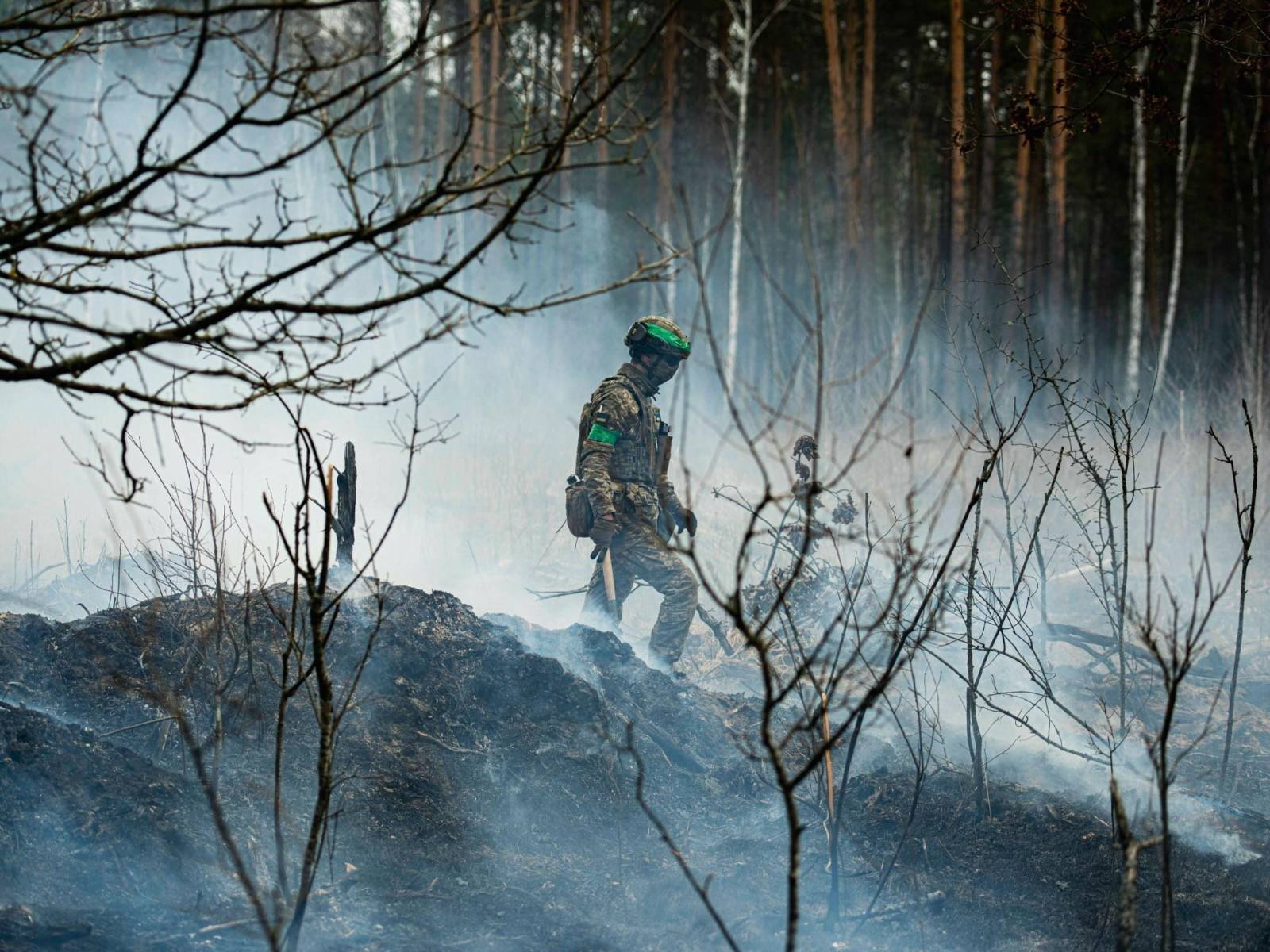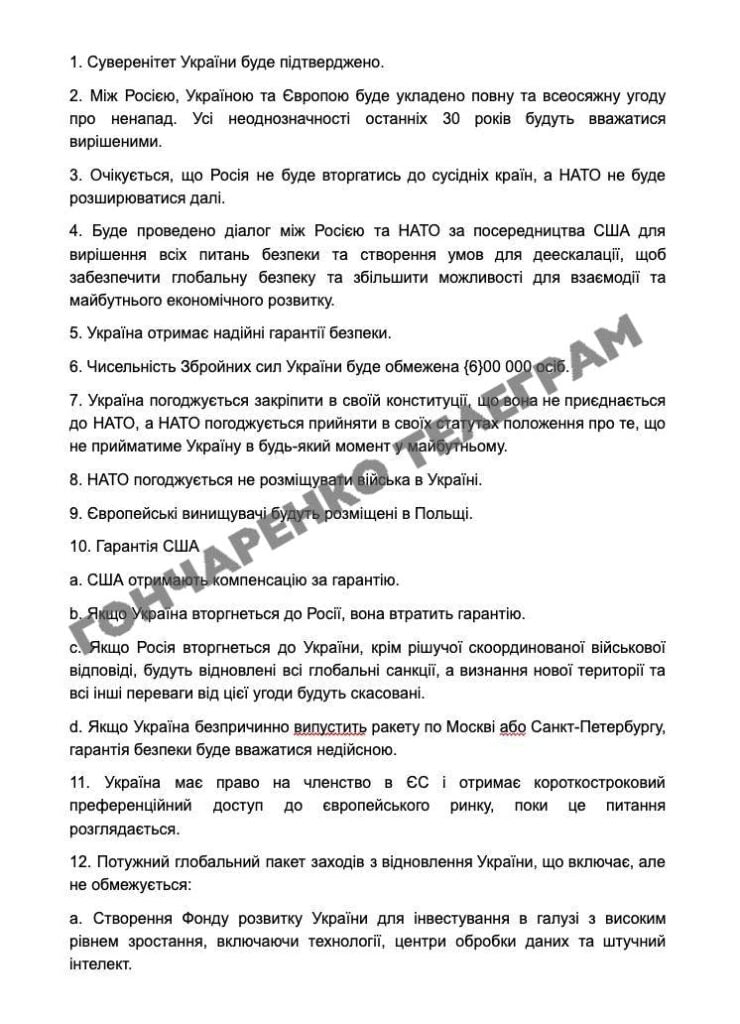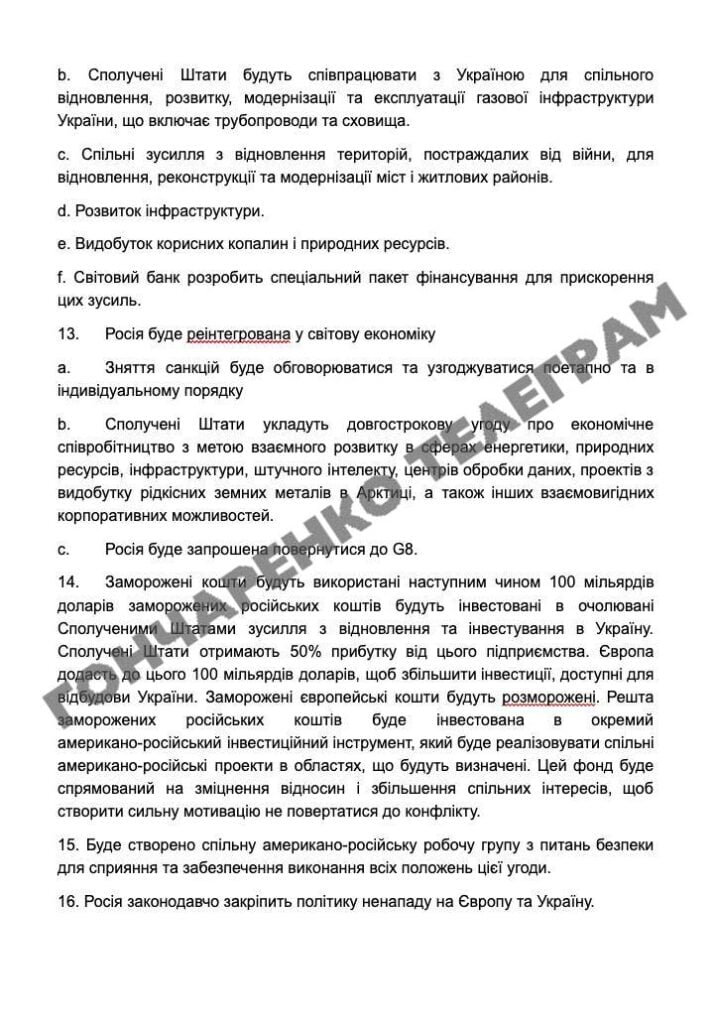Ending the war in exchange for concessions: what the draft peace memorandum offers Ukraine, Russia and the West
20 November 23:09 DOCUMENT
DOCUMENT
Ukrainians have been shown 28 points of a new “peace plan” to end the war with Russia. The document was published on November 19 by MP Oleksiy Honcharenko on his official Telegram channel.
The document begins with a declaration that Ukraine’s sovereignty is reaffirmed, and a comprehensive non-aggression agreement between Russia, Ukraine, and Europe is envisioned to close the disputes of recent decades. In parallel, Russia is expected not to invade neighboring countries, and NATO is no longer expanding.
A separate format of NATO-Russia dialog, mediated by the United States, is also envisioned for de-escalation and global security. Ukraine is promised “reliable security guarantees,” but with a large set of conditions.
Limitations for Ukraine and NATO’s role
The plan provides for a limit on the size of the Ukrainian Armed Forces – up to 600 thousand people. Ukraine has to enshrine in its Constitution its rejection of NATO membership, and NATO, in turn, undertakes to formally adopt a rule that Ukraine will not be accepted into the Alliance in the future. In turn, NATO also does not deploy troops in Ukraine, and European aviation is proposed to be deployed in Poland.
US guarantees – with reservations and “compensation”
The United States acts as a guarantor, but:
- ukraine/parties must provide compensation to the US for the guarantee;
- if Ukraine itself attacks Russia, the guarantee is lost;
- if Russia attacks Ukraine, sanctions against Russia are returned, and the new territorial recognition and benefits of the agreement are canceled;
- if Ukraine fires a missile at Moscow or St. Petersburg “for no reason”, the guarantee is also canceled.
In other words, the guarantee is described as conditional and highly dependent on the interpretation of the parties’ behavior.
Territorial block
the “Peace Plan” stipulates that Crimea, as well as Luhansk and Donetsk regions, are to be recognized as de facto Russian, including by the United States.
The LBZ is “frozen” on the territory of Kherson and Zaporizhzhia regions.
And Ukrainian troops are to withdraw from the part of Donetsk region that they currently control. A neutral demilitarized zone is being created there, and it is internationally recognized as Russian territory, with Russian troops not formally entering the buffer.
Russia, in turn, undertakes to give up other seized territories outside the five regions mentioned above.
Once the territorial arrangements are finalized, both sides undertake not to change them by force. If someone violates them, the security guarantees cease to apply.
Nuclear and energy part
The United States and Russia agree to extend their nuclear nonproliferation and nuclear arms control treaties (including START I). Ukraine reaffirms its status as a non-nuclear weapon state under the NPT.
The Zaporizhzhia NPP is to be launched under IAEA supervision, and electricity is to be shared equally (50/50) between Russia and Ukraine.
Economy, recovery and resources
A large-scale recovery package for Ukraine is proposed, including the creation of a development fund for investments in technological and high-growth sectors (technology, data centers, AI, etc.).
The United States is separately undertaking cooperation with Ukraine on gas infrastructure (pipelines, storage facilities), as well as joint projects to restore cities, infrastructure, and natural resource extraction. The World Bank should prepare a special financing package for this purpose.



Russia’s reintegration and sanctions
Russia is returning to the global economy as planned: the lifting of sanctions is being discussed in stages and on an individual basis. The US intends to sign a long-term economic cooperation agreement with Russia (energy, resources, infrastructure, AI, data centers, rare earth metals in the Arctic, and other joint projects). A separate mention is made of Russia’s invitation to the G8 format.
Frozen assets of the Russian Federation
it is proposed to use $100 billion of frozen Russian funds to finance Ukraine’s restoration in US-led structures. Official Washington would receive 50% of the profits from these investments. Europe is to add another $100 billion to increase the volume of recovery, and its frozen funds are to be unfrozen.
The rest of the Russian assets go into a separate US-Russian investment vehicle for joint projects to “strengthen the motivation not to return to the conflict.”
Humanitarian conditions and elections
A humanitarian committee is being set up. It should ensure
- the exchange of all prisoners of war and bodies on the principle of “all for all”;
- the return of all civilian detainees, including children;
- a family reunification program and measures to assist victims.
Ukraine is to hold elections within 100 days of the agreement. All parties to the conflict are promised a full amnesty for their actions during the war and a waiver of mutual claims in the future.
Control over the agreement and ceasefire
The Memorandum is declared legally binding. Control over implementation is entrusted to the “Peace Council” under the leadership of US President Donald Trump. Sanctions are provided for violations. The ceasefire comes into effect immediately after the parties withdraw to the agreed positions to start implementing the agreements.
Watch us on YouTube: important topics – without censorship
At what stage is the work on the “peace plan” now
On November 19, U.S. Chargé d’Affaires Julie Davis said that she had discussed with Volodymyr Zelenskyy an “aggressive schedule” for reaching a peace agreement.
The reasons are the stalemate in the energy sector in Ukraine and the ongoing fighting between the two armies.
The aggressive schedule for reaching a peace agreement is on President Trump’s terms, which means now, as soon as possible. This is the timetable we are working under… Some of the press reports are substantiated, and some are not. President Trump firmly believes, and this is something that General Dan Driscoll is leading here, that achieving peace will require mutual concessions from both sides. Trump is very happy with that, that’s his expectation,” the American official said.
In turn, White House Press Secretary Caroline Leavitt confirmed that the new peace plan, which official Washington calls “comprehensive,” was worked on by US Special Envoy Steve Witkoff and US Secretary of State Marco Rubio. The work on the document was conducted in secret and lasted for the last month.
They interacted equally with both sides to understand what these countries are willing to do to achieve a lasting and sustainable peace. This is a good plan for both Russia and Ukraine,” she summarized during the briefing.
Read us on Telegram: important topics – without censorship









